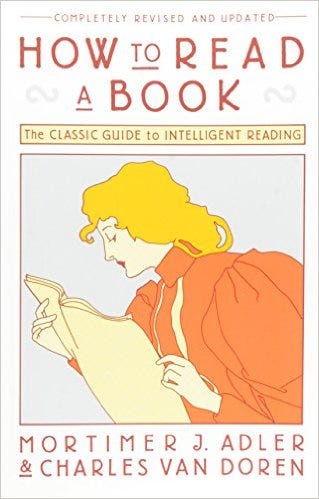Learn how to read and understand different genres of books from this classic work

Background knowledge
Each book genre differs that’s why you should not apply blindly any technique. Instead, take a common sense approach. Perhaps for some advanced or complicated books, you will need some background knowledge. That knowledge could come from your experience or by reading the author’s earlier books. That way you would learn how he developed his ideas in subsequent works. Reading other books could also help, for example by starting to read a beginners book about the topic and then later come back to the more advanced work.
Often you need some background knowledge on the book you are reading to benefit from and absorb its ideas optimally.
Inspectional reading
First of all, you should check if the book is actually what you expected it to be. You can do this by skimming through it. First, check the title page, the table of contents, the editor’s blurb and then just skim through the chapters and look for interesting and relevant parts for you.
Once you skimmed through it, you will have a better idea if the book is actually what you seek, and if not, discard it. Reading a book which does not help and interest you will not do much good.
Analytical reading
Analytical reading means, first of all, understanding the plot. Find the storyline. The starting point is the title. The title will give you probably information about the content or the category of the book already.
For example, you will know if it’s a practical how-to book, a history book, a novel, and so on. Once you’ve classified the book, you can move on to focus on the content and isolate the plot. Identify how the different themes relate to each other and the whole.
To relate different parts with each other, you have to summarize the various themes and subplots in short sentences.
Understand propositions of the author
Search for underlined or highlighted words, quotes or propositions from the author. Isolate the key sentences of the text. By doing so, you’ll understand the author’s main message or argument.
You should be able to rephrase what the author is trying to say. You also should connect one proposition with the next. Is there a logical connection between them? Often the author first presents his argument and then follows up with anecdotes and examples.
Gaining a good understanding of the propositions will give you a better understanding of the book.
Evaluate the quality of the content
Once you understand what is being said, you can consider whether it is true or probable. This is the phase where you need some critical judgment to accept or reject the information offered to you, or which portions to accept and which to reject.
Syntopical reading
Syntopical reading means you investigate a chosen question or topic and pick the relevant information from a variety of books.
It is a mix of inspectional and analytical reading because the topic you are interested in is the one being investigated, not the subject of any particular book. Instead of forming a complete picture of the books, you pick the relevant passages for your investigation.
Get “How To Read a Book” here ?.
Ready to learn more? Check out “10 days to faster reading”.
